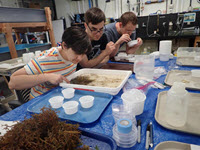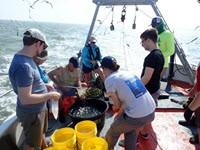
The Texas Gulf Coast is experiencing a rapid increase in oil refining and transport activities, which also increases the risk of spill-related impacts to its coastal bays and estuarine ecosystems. Marine researchers from several institutions converged on the Texas coast in June 2019 and conducted an intensive two-week biological survey, or BioBlitz, to establish a first-of-its-kind DNA census of the area’s marine organisms. This extensive library of unique DNA barcodes will help scientists efficiently assess changes in marine biodiversity in Texas coastal bay and estuarine systems affected by an oil spill or other environmental disturbances.
Nearly one-third of the United States’ oil refining capacity is situated along the Texas Gulf Coast. The Port of Corpus Christi exported a record 1.59 million barrels of crude oil per day in December 2019, which represents nearly half of all United States oil exports. Several new pipelines are under construction that will direct crude oil from West and Central Texas to a proposed site in northeast Corpus Christi Bay. Permits are under review that will deepen the Port of Corpus Christi’s ship channel to accommodate large oil tankers capable of carrying two million barrels of crude oil.
In a proactive effort to help the region be better prepared for an oil spill or other disturbance, the DROPPS III consortium and the University of Texas Marine Science Institute partnered with the Smithsonian’s Marine Global Earth Observatory (MarineGEO), the Texas A&M University-Corpus Christi, the Mission-Aransas National Estuarine Research Reserve for a DNA barcoding BioBlitz along the Texas Coastal Bend. Approximately 25 scientists, students, and volunteers collected specimens and constructed a DNA barcode library.

Using quantitative and qualitative sampling methods, the team collected 1,500 specimens from mud flats, seagrass beds, hypersaline lagoons, saltmarshes, oyster reefs, and mangroves at 68 sampling locations. They identified 396 unique taxa, including 318 invertebrates and 78 fishes, then photographed and sampled them for DNA analysis and prepared them for museum archives. Approximately twelve years of existing water quality, net ecosystem metabolism, nutrient, plankton, fish, invertebrate, and vegetation data provides an environmental context for the BioBlitz collections.
The teams deposited invertebrate specimens in the Smithsonian National Museum of Natural History (NMNH) Invertebrate Zoology Collection and Texas A&M University’s Biodiversity Research and Teaching Collections and tissue samples in the NMNH Biorepository. When genetic sequencing is complete, the sequences will be publicly available via GenBank and the Barcode of Life Data System (BOLD).
“All living things shed cells into the water that contain their DNA. With this data, a few small water samples will enable scientists to see how and why animal species change following extreme environmental events like oil spills or hurricanes,” said DROPPS Director Ed Buskey. “The environmental DNA inventory will be a treasure trove for scientists to quickly and efficiently measure who and what is living in Texas bays and estuaries. It’s a powerful tool to assess impact on marine biodiversity if a spill were to occur.”
By Nilde Maggie Dannreuther and Stephanie Ellis. Contact maggied@ngi.msstate.edu for questions or comments. Special thanks to Ed Buskey, Tracy Weatherall, and Sally Palmer with the University of Texas Marine Science Institute who provided material for this story.
************
This research was made possible in part by a grant from the Gulf of Mexico Research Initiative (GoMRI) to the consortium Dispersion Research on Oil: Physics and Plankton Studies III (DROPPS III).
The Gulf of Mexico Research Initiative (GoMRI) is a 10-year independent research program established to study the effect, and the potential associated impact, of hydrocarbon releases on the environment and public health, as well as to develop improved spill mitigation, oil detection, characterization and remediation technologies. An independent and academic 20-member Research Board makes the funding and research direction decisions to ensure the intellectual quality, effectiveness and academic independence of the GoMRI research. All research data, findings and publications will be made publicly available. The program was established through a $500 million financial commitment from BP. For more information, visit http://gulfresearchinitiative.org/.
© Copyright 2010-2020 Gulf of Mexico Research Initiative (GoMRI) – All Rights Reserved. Redistribution is encouraged with acknowledgement to the Gulf of Mexico Research Initiative (GoMRI). Please credit images and/or videos as done in each article. Questions? Contact web-content editor Nilde “Maggie” Dannreuther, Northern Gulf Institute, Mississippi State University (maggied@ngi.msstate.edu).
